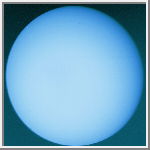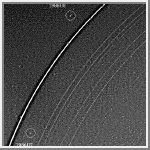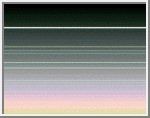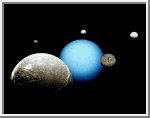















|
The important thing is not to stop questioning.
- Albert Einstein
| Introduction |
|---|
Uranus is the seventh planet from the Sun and is the third largest in the solar system. It was discovered by William Herschel in 1781. It has an equatorial diameter of 51,800 kilometers (32,190 miles) and orbits the Sun once every 84.01 Earth years. It has a mean distance from the Sun of 2.87 billion kilometers (1.78 billion miles). The length of a day on Uranus is 17 hours 14 minutes. Uranus has at least 15 moons. The two largest moons, Titania and Oberon, were discovered by William Herschel in 1787.
The atmosphere of Uranus is composed of 83% hydrogen, 15% helium, 2% methane and small amounts of acetylene and other hydrocarbons. Methane in the upper atmosphere absorbs red light, giving Uranus its blue-green color. The atmosphere is arranged into clouds running at constant latitudes, similar to the orientation of the more vivid latitudinal bands seen on Jupiter and Saturn. Winds at mid-latitudes on Uranus blow in the direction of the planet's rotation. These winds blow at velocities of 40 to 160 meters per second (90 to 360 miles per hour). Radio science experiments found winds of about 100 meters per second blowing in the opposite direction at the equator.
Uranus is distinguished by the fact that it is tipped on its side. Its unusual position is thought to be the result of a collision with a planet-sized body early in the solar system's history. Voyager 2 found that one of the most striking influences of this sideways position is its effect on the tail of the magnetic field, which is itself tilted 60 degrees from the planet's axis of rotation. The magnetotail was shown to be twisted by the planet's rotation into a long corkscrew shape behind the planet. The magnetic field source is unknown; the electrically conductive, super-pressurized ocean of water and ammonia once thought to lie between the core and the atmosphere now appears to be nonexistent. The magnetic fields of Earth and other planets are believed to arise from electrical currents produced in their molten cores.
In 1977, the first nine rings of Uranus were discovered. During the Voyager encounters, these rings were photographed and measured, as were two other new rings and ringlets. Uranus' rings are distinctly different from those at Jupiter and Saturn. The outermost epsilon ring is composed mostly of ice boulders several feet across. A very tenuous distribution of fine dust also seems to be spread throughout the ring system.
There may be a large number of narrow rings, or possibly incomplete rings or ring arcs, as small as 50 meters (160 feet) in width. The individual ring particles were found to be of low reflectivity. At least one ring, the epsilon, was found to be gray in color. The moons Cordelia and Ophelia act as shepherd satellites for the epsilon ring.
| Animations of Uranus |
|---|
| Views of Uranus |
|---|
 Uranus
Uranus
This view of Uranus was acquired by
Voyager 2 in January 1986.
The greenish color of it atmosphere is due to methane and
high-altitude photochemical smog.
(Credit: Calvin J. Hamilton)
 Uranus in True and False Color
Uranus in True and False Color
These two pictures of Uranus, one in true color
(left) and the other in false color, were compiled from images returned
January 17, 1986, by the narrow-angle camera of Voyager 2. The spacecraft was
9.1 million kilometers (5.7 million miles) from the planet, several days
from closest approach. The picture at left has been processed to show
Uranus as human eyes would see it from the vantage point of the
spacecraft. The picture is a composite of images taken through blue, green
and orange filters. The darker shadings at the upper right of the disk
correspond to the day-night boundary on the planet. Beyond this boundary
lies the hidden northern hemisphere of Uranus, which remains in
total darkness as the planet rotates. The blue-green color results from
the absorption of red light by methane gas in Uranus' deep, cold and
remarkably clear atmosphere. The picture at right uses false color and
extreme contrast enhancement to bring out subtle details in the polar
region of Uranus. Images obtained through ultraviolet, violet and orange
filters were respectively converted to the same blue, green and red colors
used to produce the picture at left. The very slight contrasts visible in
true color are greatly exaggerated here. In this false-color picture,
Uranus reveals a dark polar hood surrounded by a series of progressively
lighter concentric bands. One possible explanation is that a brownish haze
or smog, concentrated over the pole, is arranged into bands by zonal
motions of the upper atmosphere. The bright orange and yellow strip at the
lower edge of the planet's limb is an artifact of the image enhancement.
In fact, the limb is dark and uniform in color around the planet.
(Courtesy NASA/JPL)
 Voyager Farewell Image
Voyager Farewell Image
This view of Uranus was recorded by Voyager 2 on
January 25, l986, as the spacecraft left the planet behind and set forth
on its cruise to Neptune. Voyager was 1 million
kilometers (620,000 miles) from Uranus when it acquired this wide-angle
view. The picture, a color composite of blue, green and orange frames,
has a resolution of 140 kilometers (90 miles). The thin crescent of Uranus
is seen at an angle of 153 degrees between the spacecraft, the planet
and the Sun. Even at this extreme angle, Uranus
retains the pale blue-green color seen by ground-based astronomers and
recorded by Voyager during its historic encounter. This color results from
the presence of methane in Uranus' atmosphere; the gas absorbs red
wavelengths of light, leaving the predominant hue seen here. The tendency
for the crescent to become white at the extreme edge is caused by the
presence of a high-altitude haze.
(Courtesy NASA/JPL)
 Hubble Tracks Rotation of Uranus
Hubble Tracks Rotation of Uranus
This view of Uranus was acquired by NASA's Hubble Space Telescope and
reveals a pair of bright clouds in the planet's southern hemisphere,
and a high altitude haze that forms a "cap" above the planet's
south pole. This is just one view of a sequence of three that can
be obtained by selecting the above gif image.
Hubble's new view was obtained on August 14, 1994, when Uranus was 2.8 billion kilometers (1.7 billion miles) from Earth. These atmospheric details were only previously seen by the Voyager 2 spacecraft, which flew by Uranus in 1986. Since then, detailed observations of Uranus's atmospheric features have not been possible because the planet is at the resolution limit of ground-based telescopes.
Hubble's Wide Field Planetary Camera 2 observed Uranus through a filter that is sensitive to light reflected by a pair of high altitude clouds. This makes a high altitude haze over Uranus' south polar region clearly visible, along with a pair of high altitude clouds or plume-type features that are 4,300 and 3,100 kilometers (2,500 and 1,800 miles) across, respectively. (Credit Kenneth Seidelmann, U.S. Naval Observatory, and NASA)
Two additional Hubble Telescope images can be found here.
 Shepherd Satellites
Shepherd Satellites
 Pseudo-image of Uranus' Ring
Pseudo-image of Uranus' Ring
 Uranus' Rings
Uranus' Rings
 Uranus Family
Uranus Family
| Rings of Uranus |
|---|
The following is a summary of the rings of Uranus.
| Name | Distance* | Width | Thickness | Mass | Albedo |
|---|---|---|---|---|---|
| 1986U2R | 38,000 km | 2,500 km | 0.1 km | ? | 0.03 |
| 6 | 41,840 km | 1-3 km | 0.1 km | ? | 0.03 |
| 5 | 42,230 km | 2-3 km | 0.1 km | ? | 0.03 |
| 4 | 42,580 km | 2-3 km | 0.1 km | ? | 0.03 |
| Alpha | 44,720 km | 7-12 km | 0.1 km | ? | 0.03 |
| Beta | 45,670 km | 7-12 km | 0.1 km | ? | 0.03 |
| Eta | 47,190 km | 0-2 km | 0.1 km | ? | 0.03 |
| Gamma | 47,630 km | 1-4 km | 0.1 km | ? | 0.03 |
| Delta | 48,290 km | 3-9 km | 0.1 km | ? | 0.03 |
| 1986U1R | 50,020 km | 1-2 km | 0.1 km | ? | 0.03 |
| Epsilon | 51,140 km | 20-100 km | < 0.15 km | ? | 0.03 |
*The distance is measured from the planet center to the start of the ring.
| Uranus Moon Summary |
|---|
The following table summarizes the radius, mass, distance from the planet center, discoverer and the date of discovery of each of the moons of Uranus:
| Moon | # | Radius (km) | Mass (kg) | Distance (km) | Discoverer | Date |
|---|---|---|---|---|---|---|
| Cordelia | VI | 13 | ? | 49,750 | Voyager 2 | 1986 |
| Ophelia | VII | 16 | ? | 53,760 | Voyager 2 | 1986 |
| Bianca | VIII | 22 | ? | 59,160 | Voyager 2 | 1986 |
| Cressida | IX | 33 | ? | 61,770 | Voyager 2 | 1986 |
| Desdemona | X | 29 | ? | 62,660 | Voyager 2 | 1986 |
| Juliet | XI | 42 | ? | 64,360 | Voyager 2 | 1986 |
| Portia | XII | 55 | ? | 66,100 | Voyager 2 | 1986 |
| Rosalind | XIII | 27 | ? | 69,930 | Voyager 2 | 1986 |
| Belinda | XIV | 34 | ? | 75,260 | Voyager 2 | 1986 |
| Puck | XV | 77 | ? | 86,010 | Voyager 2 | 1985 |
| Miranda | V | 235.8 | 6.33e+19 | 129,780 | G. Kuiper | 1948 |
| Ariel | I | 578.9 | 1.27e+21 | 191,240 | W. Lassell | 1851 |
| Umbriel | II | 584.7 | 1.27e+21 | 265,970 | W. Lassell | 1851 |
| Titania | III | 788.9 | 3.49e+21 | 435,840 | W. Herschel | 1787 |
| Oberon | IV | 761.4 | 3.03e+21 | 582,600 | W. Herschel | 1787 |

 Return to Saturn
Return to Saturn
 Voyage to Neptune
Voyage to Neptune
